How to Process Acorns for Food

Are acorns edible?
Amazingly, many people ask this question with a great deal of skepticism, often followed by "they're toxic!... aren't they?"
Well, yes, and no.
Acorns are toxic due to the presence of bitter, astringent polyphenols known as tannins (what makes wine so delicious, to many), but like other food staples across the globe (manioc root [Manihot esculenta], as an excellent example, is actually deadly if not properly processed first) it's all in the processing. However, some acorns are consumed with no processing, whatsoever.
The oldest proof of humans consuming acorns (along with pistachios and almonds) is found in the Jordan valley (Gesher Benot Yaaqov Paleolithic site) dating to 750,000 BC (there is debate as to whether these were early humans or hominids). Yes, 752,000 years ago. The site is estimated to have been used for about 100,000 years, so they were at it for awhile. In fact, many sites which are presumed to predate agriculture but were sedentary possess acorn remnants as a common feature. According to one researcher, if one were to lay out all the foods consumed by humans over our time on earth, up to this point, on one pretty large table, piled according to the relative amount which we have eaten, collectively, over time, then acorns would most certainly comprise the largest pile of anything we have consumed.
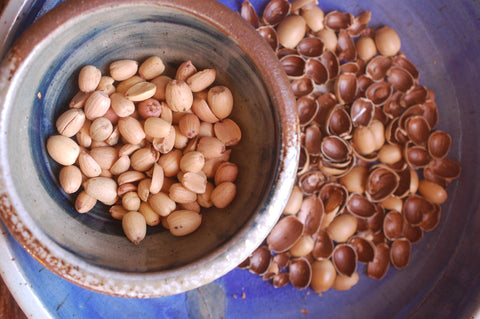
- Quercus arizonica - Arizona oak acorns
All oaks produce acorns - in most years, if not all - and all acorns are edible. Yes, all acorns are edible. That's right. But a majority of oak species require a very basic processing technique, referred to as leaching, before becoming edible and palatable.
So, should there be any question as to whether acorns are edible, or not?
Like the vast majority of children growing up in the U.S. for several generations now, I never saw acorns on the dinner menu. In fact, I hadn't the faintest idea they were edible, by my recollection. They fell abundantly at times and could cover the ground. Then, eventually, they were gone... swept away by the flooding rains of autumn, or covered by winter's first snow fall, if not already stashed away by the vast population of neighborhood squirrels.
Aside from your average wild food enthusiast, or foraging aficionado, (both of which are small minorities in this culture, believe it or not), the vast majority of the population either pays acorns absolutely no mind whatsoever, they believe them to be inedible, or some refer to them as "poison." I would hope that what I will share with you here will help dispel these misconceptions, if so held, if not otherwise provoke some "acorn enthusiasm" for the gustatory cortex.

- Acorn chocolate chip cookie with pecans
I have been gathering, processing, eating, experimenting with, and researching acorns for over a decade. This being my first post, or article, on acorns I needed to reign myself in on all that I'd like to say. Although I am well short of putting together a book on the subject - that is certainly a dream of mine (any enthusiastic, foreward [and backward] looking financiers ready to fund a year-long study of acorn consumption in North America?) - I have a lot I'd like to share. However, I would like to focus this post on how to effectively process acorns for food once gathered.
First of all, you need to identify your oaks. What type, or species, of oak doesn't really matter so much if you simply pay attention to what you do have. You will discern its properties according to your own experience and taste. Oak trees can be deciduous (they lose their leaves in the winter) or evergreen. The leaves will generally be lobed (to some degree) with tips finishing in a point, or rounded. These are generalizations, and as with all things in Nature exceptions always occur.

- Quercus rugosa - margins with sharp points
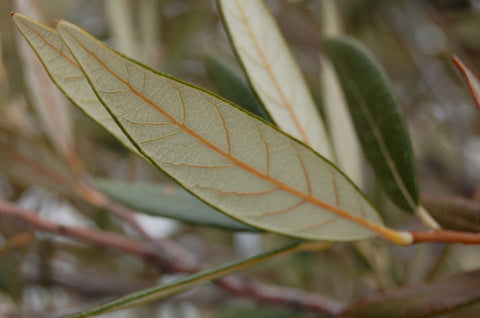
- Quercus hypoleucoides -entirely smooth margins
I'd like to say one more thing before we begin the discussion of processing. You can certainly find a variety of acorn processing methods described on the internet, including videos. Much of the information you'll find will contradict what I tell you here (and vice versa), and some of it is actually really useful information as well. I'll also say there are other methods that are perhaps more viable for you and where you are at, and the acorns you have. I am in the Sonoran desert, in Tucson, AZ. This method works really well for me here. Undoubtedly, there is someone who will come up with better, more efficient methods than what I propose here (including myself). Let's just call it a work-in-progress.
Step #1 - Dry the Acorns
Regardless of whatever type of acorn you have, the first thing you are going to do is dry them in the sun. This should take anywhere from 1-4 weeks depending on your weather conditions. One simple thing to remember: don't pile the acorns more than 1-2 acorns deep. Any deeper than this and you will greatly extend your drying time. Turn them over several times each day with your hands while in the sun. Spread out over a screen with air flow beneath is optimal. Direct sun is just fine.

- Sun drying acorns
How to tell your acorns are dry enough? For one, they will be much lighter. Also, you'll be able to crack the shells more easily as they lose their plasticity as they dry. Once opened, inspect the nut to see if it is soft or hard. A bit of softness within the center of the acorn is okay. But they should be dry all around the surface before proceeding to the next step.
Once fully dry, you have the option of storing them, unshelled, in a cool, dark place before proceeding to process them. Although unshelled acorns take up more space, I believe they will store longer than shelled acorns. Additionally, once fully dry, they are not susceptible to insect predation.
Step #2 - Shell the Acorns
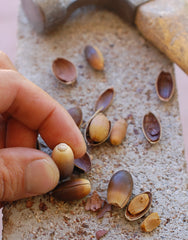
- Shelling acorns by hand
This stage has likely seen many a bucket of acorns thrown to the compost pile or some such refuse heap. For it is no easy task to shell acorns by hand, especially for those of us who can so easily procure nutritious and tasty food simply by swiping our card at the supermarket. However, after years of single acorn cracking with my hammer, I recently invested in the Davebilt Nutcracker after years of deliberation on this expense. Folks, this is well worth it for the acorn harvester. In time spent, it pays for itself within a season, undoubtedly.
Nonetheless, this is the stage where we separate the shell from the nut and discard the shell. Many may ask here, "Why not skip the sun drying step and do this straight away?" Excellent question. Many certainly do. And they will go through painstaking efforts to do so, such as cutting each acorn open with a knife, shears, or pruners, and peeling away the shell which is seemingly welded to the fresh acorn meat. Not my idea of fun. With a little patience up front, you can be cooking with last year's harvest while you casually process this year's.
With the Davebilt Nutcracker I can crack open 2 gallons of acorns in about 5-10 minutes. There is an adjustment on the machine
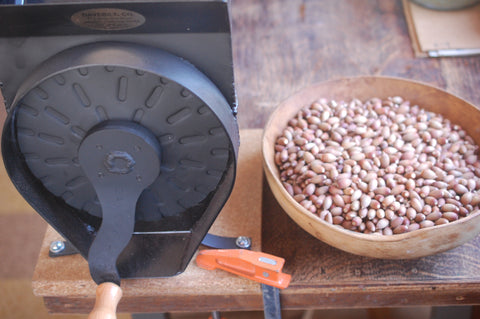
- The Davebilt Nutcracker
which allows you to accommodate for various size nuts. The next step is to separate the shells from the nuts. For this, I employ water. I place about 2-3" of shell and nut fragments in the bottom of a clean, food grade 5 gallon bucket. Then fill the bucket with clean water. Now all the loosened shells will float to the top and I scoop them up to discard with a handheld sieve, or strainer. About 40% of the shells will have remained adhered to the nut meats at the bottom of the bucket, so I'll lightly rustle them with my hand to cause them to float up. Then I'll slowly reach in with my sieve and scoop them out. I'll usually repeat this step about 10-15 times until I've removed most of the shells. Then I strain out all of the water and pick out the remaining shell pieces by hand. Perhaps I'll allow the soaked material to first sun dry a bit before handling them. The most laborious section of a relatively easy process.
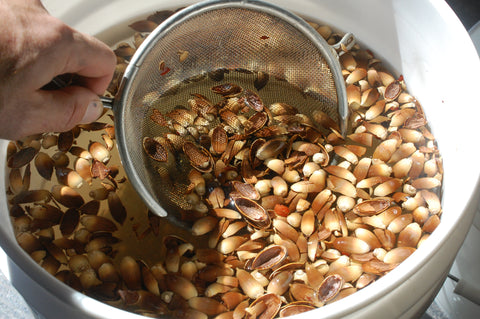
- Scooping acorn shells off the surface of the water
Step #3 - Leaching the Acorns
Remember what I said about tannins? These are our principle nemesis, if you will, when it comes to eating acorns. We want to remove them by way of exposure to water. The way to get the most exposure to water across the surface area of the acorn is to first grind the acorn. This coincides with the extant traditional practices of acorn processing in North America and Asia. Some may choose to do this with fresh acorn meat (completely viable), or, as I'm describing here, with dry, ground acorn meal. I will grind my acorns in a blender or vitamix, bit by bit, pouring the ground contents through a fine sieve over a large bowl or bucket, then placing the larger pieces back in the vitamix for the next round of blending. If I'm making bread, biscuits, cookies, or a variety of other baked goods I will often toss the larger pieces in. If they don't "disappear" in the dough, they often lend a nice texture to the food.
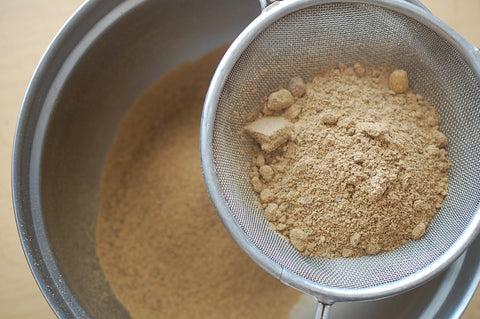
- Sifting ground acorn flour
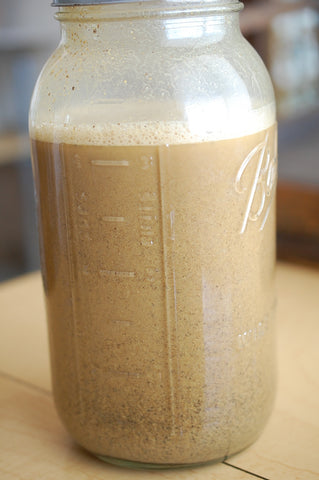
- Leaching tannins from acorns with cold water
Leaching methods are usually separated as either "hot" or "cold," and this refers to the temperature of the water used in the leaching process. To keep this section short and to the point, I will simply say here that the cold leaching method affords a noticeably more adhesive type of acorn flour which is exceptionally advantageous in gluten-free baking. The flour sticks to itself more readily. I highly recommend it. The "hot" leaching method for acorns is believed to be faster, but I believe my method is fast enough, and I really do like the quality of "cold" leached acorn flour.
I use a half gallon canning jar for leaching. They fit well in the kitchen cabinet, they have many uses, and they serve to leach about 1-1.25 cups of acorn flour in 5-10 minutes. Yes, that's all it takes. Not days, or weeks, or months as many other methods describe. First I add the acorn flour (1-1.25 cups), then fill the jar with clean water. I then shake it vigorously until it resembles a pale chocolate milkshake, or a frappaccino. The acorn meal will settle within several minutes. I'll shake it again. Meanwhile, I can be tending to other duties in the kitchen, or nearby. If I wished to speed this up a bit, I would continually shake the jar for several minutes. This, I theorize, would hasten the release of the tannins into the water through the excited movement of the molecules until saturation takes place. So, after several shakes and settlings, or several minutes of continuous shakings, you can begin to pour the contents out through a strainer. I have used several things here. Muslin cloth (jelly bag) holds in most of the finest particles, but can take several hours to drain all the water. A bandana is similar, but slightly quicker. A nylon nutmilk bag (my current favorite) will drain all the water almost instantly, but you will lose the finest flour (upwards of 30-50% of your volume). But that's okay, we can get it back. I squeeze out as much moisture as I can by hand. At which point I have moist, leached, acorn flour ready to apply to any recipe I may have. Otherwise, I can dry the flour for storage and later use. In our dry climate, I can often get away with drying this amount on a plate over 24 hours time. I can get it bone dry overnight in the electric dehydrator. Or an afternoon in direct warm sunshine. I keep all my acorn flour in the refrigerator, or, space permitting, in the freezer. It has become an accepted luxury in our home to have fully processed acorn flour available on demand.
This entire process can take me about 2 hours total time for about 2 gallons of sun dried acorns. I will generally spread it out over a couple days, if not several, working it into my available kitchen time. Steadily, I build up a supply, then we eat it up. And the cycle continues.
There are several things I really enjoy about cooking with and eating acorns. Some of which are the sense of being connected to an ancient practice in my daily urban lifestyle, the process of gathering our own food from a local park, sharing this experience with my 4 year old daughter who has already been through several harvesting seasons, and exploring the texture and the behavior of the material itself as I learn to make beautiful food from this most ancient source of human nutrition.

- Raw, shelled Emory oak acorns, or bellotas
In a future post I will bring out some recipes from a selection of some of my favorites including sourdough acorn pancakes, acorn-mesquite biscuits, acorn mountain spice burgers, acorn-piñon nut cake, acorn-saguaro seed bread, and acorn chocolate chip cookies.
Fortuitous Foraging!
**If you'd like John to come teach an acorn processing workshop in your area, you can contact him at john@johnjslattery.com
Further Reading & Viewing:
Acorn recipe from the Miwok of California: http://www.nativetech.org/recipes/recipe.php?recipeid=115
From Tree to Table: gathering and processing acorns by Arthur Haines of The Delta Institute: https://www.youtube.com/watch?v=QitkIGNwUgs
Greene Deane from Eat the Weeds: http://www.eattheweeds.com/acorns-the-inside-story/
Stone Age Acorn Preparation in the UK (Video): http://youtu.be/-pwGpLjsWmc
Wild Harvests. How to Eat an Acorn: http://arcadianabe.blogspot.com/2012/11/how-to-eat-acorn.html












So, I collected SO MANY ACORNS this year. There is no way I can set them out in the sun without losing most or all to the local squirrels, and I probably won’t have time to shell them for another week or two. Can I stick the unshelled acorns in my dehydrator instead of sundrying them? Otherwise, will they go bad if I don’t dry them but can’t shell them for two weeks? Tyvm!
This wet 2018 year in Rapid City, SD has given us huge acorns from Burr Oak. So my husband and I are making acorn flour. I am learning so much. Thanks for sharing your experiences with processing acorns. Wait until I wow my Native American friends with acorn bread! Your best tip is to keep the flour in our freezer. And I can store dried acorns in our cool basement area to process again during Thanksgiving.
After watching your video I had to try out the Emory oak acorns.
My wife and I both tried them raw out of the shell and found them edible, but not terribly tasty.
I shelled a bunch of them and processed them in my Ninja single serving blender which chopped them up very fine. The biggest bits were like corn meal while much of it was almost like flour.
I let them sit in a 1/2 quart mason jar in water for about 14 hours, then strained it through a cotton tee shirt.
We then tasted the meal. The slight bitterness was all but gone. Not bad!
So we cooked them into some pancake mix from scratch and had some really nice pancakes.
It was a very interesting experience and I plan to do some further exploration into acorns as food.
Studying this gave me a whole new perspective on the native Americans that have lived in this area over time. I always tended to think of them more in terms of hunting vs gathering, but now I can see that the gathering part was probably the greater and more fruitful endeavor for them.
Thanks for all the great information!
Beautiful instruction set, thank you so much! I hope someone takes you up on funding a book on this because your writing style is perfect for it. I’m curious as to what the flavor of acorns is, and their nutritional content. Does it vary with variety of tree?
Leave a comment